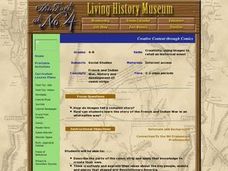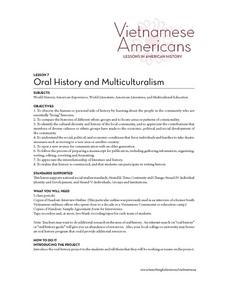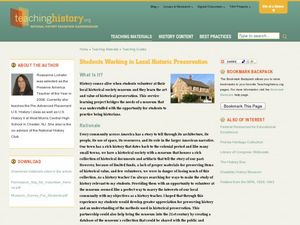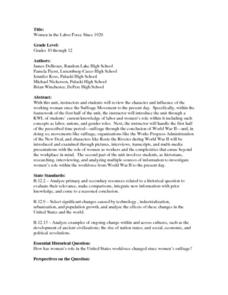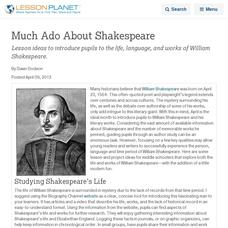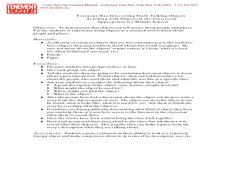Curated OER
Follow The Road to Riches
Students examine the various events occurring at the time of the Gold Rush. They see archival photographs and hear historians talk about this era. They create a time line in order to facilitate thinking about this region during the...
Curated OER
Horse Warriors
Students compare the Roman Empire, medieval Europe and feudal Japan. In this warrior societies instructional activity, students research the 3 warrior societies and share their research findings with their classmates.
Curated OER
The Work of an Historian
Students examine the life of John Pynchon and his role in the Connecticut River Valley's development.
Curated OER
Research as a Historian, as an Artist
Students work together to research one area of history that is of an interest to them. Using primary sources, they examine photographs and disuss what they already know about the topic. They present their images and information to the...
Curated OER
The Mystery of the Shoe Box
Sixth graders do the work of historians. In this world history lesson, 6th graders examine the artifacts and handouts in mystery boxes that their teachers prepare. Students collaborate to solve the mystery of their assigned boxes as they...
Curated OER
Japan
In this Japan activity, students read a 2 page article on Japan, answer 3 facts about Japan with multiple choice answers, fill in 4 blanks in 4 statements and answer two statements as true or false.
National First Ladies' Library
Riding the Underground Railroad
Young historians explore the underground railroad and life as a slave during the Civil War. After internet research, they discuss the hazards of travel as a slave and the benefits of freedom. Individually, students write a short story...
Curated OER
Galveston 1900: Storm of the Century
Seventh graders comprehend the effect the 1900 Hurricane, the deadliest natural disaster in United States history, had on Galveston by examining period accounts and photographs. They comprehend how the devastation of the hurricane lead...
Curated OER
Creative Content through Comics
Students identify the different parts of a comic strip and creat their own about the French and Indian War period. They share their comics with the class. They can compile them into a newspaper format if they choose.
Curated OER
Oral History and Multiculturalism
Students observe the human or personal side of history by assessing the background to the people in the community who are basically "living" historians. They compare the histories of different ethnic groups to identify areas of patterns...
Curated OER
Looking and Learning in the Art Museum
Young art historians review the elements of art by studying a reproduction of a work of art from a museum visit. They explain the difference between looking at a reproduction of a work of art and looking at the original...
Curated OER
Students Working in Local Historic Preservation
Students develop an appreciation of history as they volunteer their time in historical museums. In this historical perspectives lesson plan, students work with valuable local documents as they aid the staff of selected local historical...
Curated OER
Ceramics: A Vessel into History
Students create a personal clay vessel that has a specific use or meaning in their contemporary culture, which could be discerned through study by future archeologists and art historians.
Curated OER
The Power of Journals: Going Beyond the Text
Eighth graders define and use new vocabulary and identify the reasons why Native Americans captured Europeans during the colonial period. They write their own journal entries about the topic and explain the importance of journals as a...
Curated OER
Women In The Labor Force Since 1920
Students investigate the historical perspective of how women were perceived in the labor force since 1920 forward. They conduct research that focuses on how the role of women has changed in different periods of time. They identify the...
Curated OER
Restoring the Nike
Students explore the roles of artists, art historians and archaeologists. They discover the role of professionals in restoring lost or damaged artwork. Students examine the characteristics of Greek art.
Curated OER
Gourmet Chef or Fast Food Mama?
Young scholars examine the contents of a 17th century women's kitchen. Using probate records, they compare them with a historian's record of the same event. They complete an inventory of a kitchen of a women in their own lives.
Curated OER
Ceramics: A Vessel Into History
Students evaluate the work of their peers using the criteria for value and meaning they developed. In this ceramics lesson, students evaluate their peers’ vessels in their journals by responding to the given questions...
Curated OER
Find the Tallest
Students use a variety of local resources to find pictures and information about the tallest structures in your town during four different periods. By comparing pictures, students gather information about a town's values, major...
Curated OER
The Cuban Missile Crisis-Three Perspectives
Pupils examine the viewpoints of the major players in the Cuban Missile Crisis. In groups, they research the topic and organize the information into a presentation. They evaluate the decisions made at the time. They also discover the...
Briscoe Center for American History
Mary Maverick and Texas History - Part 2
To conclude their investigation of the life of Mary Maverick and to demonstrate their ability to analyze primary source documents, groups use the SOAPS questioning method to examine Maverick's account of events in early Texas history.
Curated OER
Much Ado About Shakespeare
Lesson ideas to introduce pupils to the life, language, and works of William Shakespeare.
K12 Reader
The Mayflower
The journey aboard the Mayflower in 1620 was long and arduous for the Pilgrims set for the New World. Learn about the difficulties of the expedition, including the extended timeframe and cramped quarters, with an informative reading...
Curated OER
Everyone Has Interesting Stuff: Talking Objects Teaching with Objects in the Classroom
What fun! Have your class compose a narrative piece from an object's point of view. They research the object, its origin, and its history, then write their story. Stories can be shared with the class or read to children in a younger grade.










